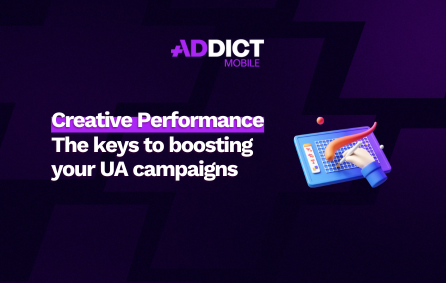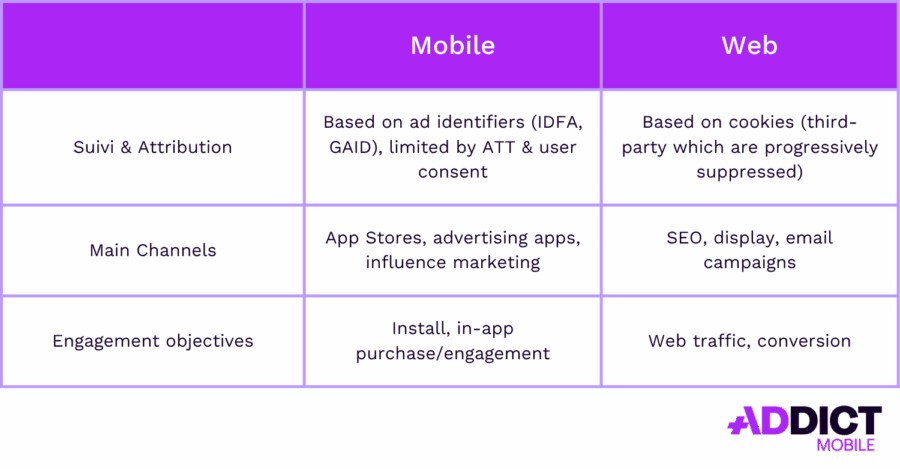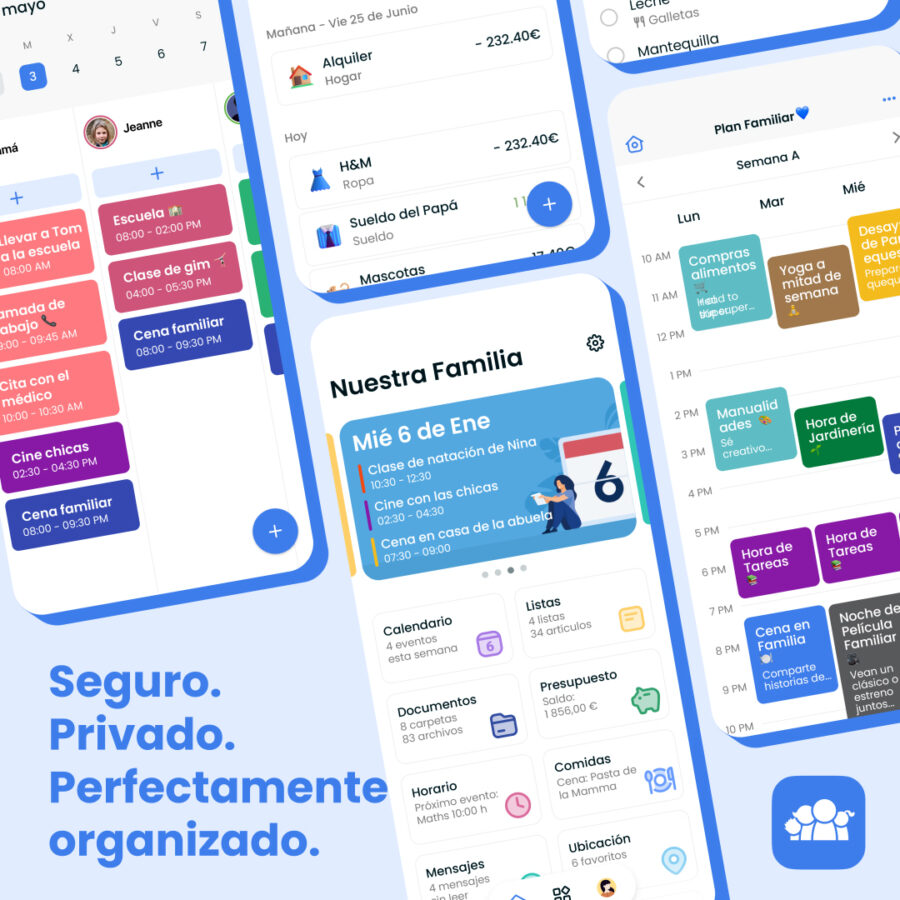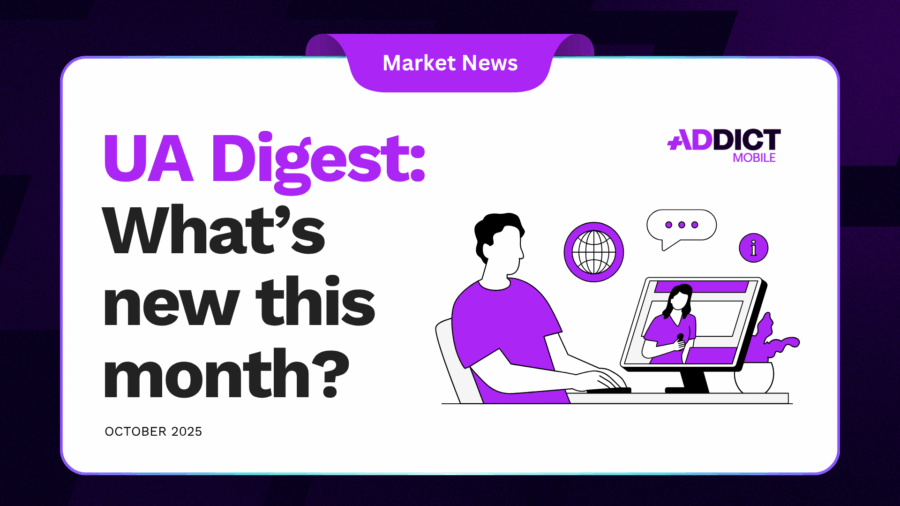Why is implementing a User Acquisition strategy for your app essential?
In an ultra-competitive mobile market, having an effective User Acquisition (UA) strategy is key to getting the most out of your media budget and maximizing ROI. At Addict Mobile, we’ve developed a proven methodology to deliver strong and scalable performance.
What’s Inside?
First, what is a User Acquisition strategy?
A User Acquisition (UA) strategy for an app refers to all the actions and tactics designed to attract new users. The main goal is to encourage users to download the app and engage with it over time.
A well-designed UA strategy helps:
- Increase the number of installs
- Improve store rankings (App Store, Google Play) by driving high install volumes
- Drive revenue or long-term engagement
6 key steps to implement a UA strategy
1. Understand your target audience
The first step in a UA strategy is identifying your ideal users based on their demographics, behavior, and interests.
Example: For an app like FuboTV, the target would be sports fans, heavy streaming content consumers, and those interested in sports news.
Tip: Precise segmentation helps personalize ad messages and maximize impact.
2. Choose the right acquisition channels
Acquisition channels should be selected based on campaign goals, audience, and geolocation. Here are the main ones to consider:
- Ad networks: Meta, TikTok, Snapchat, Apple Search Ads, Google Ads, and DSPs (Demand-Side Platforms) like Moloco.
- App Store Optimization (ASO): A key element in any UA strategy, ASO focuses on optimizing descriptions, icons, visuals, and keywords to improve app visibility in the stores.
- Influencer marketing: Partnering with influencers to promote the app to their audience. UGC (User Generated Content) is a strong format for driving engagement with relevant messaging.
- Affiliate marketing: Working with affiliate networks to generate installs based on a Cost Per Install (CPI) model.
Example: For the mobile game Sush, two videos were designed specifically for TikTok and Snapchat, channels particularly effective for reaching a younger audience.
3. Create engaging creative assets
Ad creatives must grab users’ attention while showcasing the app’s value. Concepts and formats should be adapted to each channel, respecting their specific codes and best practices.
Types of creatives:
- Short videos: Ideal for TikTok or Meta, this format needs to hook users within the first few seconds. It should follow safe zones and include key elements like catchy music, subtitles, and filters.
- Static visuals: A useful format for showcasing products or highlighting a promotional offer.
- Optimized screenshots: Used to highlight key features or app benefits directly in the app stores.

Tip: Test different variations to identify what resonates best with your audience. At Addict Mobile, we offer Creathor, a creative technology that allows us to produce a high volume of assets in record time.

Boost your UA campaigns with Creative Performance
4. Measure and optimize performance
Tracking the right metrics is key to analyzing campaign effectiveness and adjusting efforts accordingly.
Key KPIs:
- CPI (Cost Per Install): Average cost per app install.
- ROAS (Return on Ad Spend): Return generated from advertising spend.
- Retention rate: Percentage of users still active at D+1, D+7, or D+30.
- LTV (Lifetime Value): Total value generated by a user throughout their lifecycle.
Tip: Using MMPs such as AppsFlyer, Adjust, or Branch is essential to track user journeys and attribute installs to ad campaigns.
5. Retain and engage users
User retention is key to maximizing app revenue. Post-install engagement is a metric to watch closely.
Here are a few engagement tactics:
- Push notifications: Keep users informed about promotions or new features.
- Personalized offers: Share exclusive rewards or content to boost activity.
- Gamification: Add challenges or levels to encourage users to come back.
6. Allocate your budget wisely
Effective budget management, at the heart of the Addict Mobile approach, is essential to maximize ROI. It’s crucial to regularly monitor channel performance to make informed decisions about how budget is distributed. This helps both optimize marketing spend and boost results.
Example: If TikTok generates a ROAS of 200% while Snapchat delivers only 120%, allocate more to the first one.
What’s the difference between a mobile and a web UA strategy?
While both share similar goals, they differ in several key areas:
1. Conversion tracking and attribution
- Mobile: Relies on advertising IDs (IDFA, GAID) or attribution tools. Since iOS 14.5, App Tracking Transparency (ATT) has significantly limited tracking without user consent.
- Web: Primarily uses cookies, which are easier to track, but increasingly restricted (e.g., deprecation of third-party cookies).
2. Main channels
- Mobile: Focus on app stores, ad networks, and influencer marketing.
- Web: Focus on SEO, display advertising, and email campaigns.
3. Engagement goals
- Mobile: The goal is usually installs followed by in-app engagement.
- Web: The main goal is typically driving traffic to the site.


Don’t hesitate to reach out to our team
Addict can support you in improving your performance.
What are some tips to maximize your UA strategy?
1. Leverage Artificial Intelligence (AI)
Use AI tools to analyze performance in real time, predict user behavior, and automatically adjust ad bidding. Ad platforms are increasingly integrating machine learning to better tailor campaigns to audiences and drive stronger performance.
2. Focus on personalization
With limited user data, leverage anonymized models to create tailored messages for each audience segment. Adapt your visuals based on the audience, with our creative technology, you can easily update visual elements (e.g., products), translate, or personalize messages based on seasonality, location, or behavior, all in just a few clicks.


For FamilyWall, visuals were adapted into three languages (FR, EN, ES) and tailored to seasonal highlights like Black Friday or New Year’s to align with local timing and market specifics.
3. Diversify your channels
Explore emerging or audience-specific channels to drive higher engagement.
4. Prioritize ID-less strategies
Adopt approaches like contextual targeting to work around privacy regulations and targeting limitations.
5. Collaborate with local influencers
Localization and authenticity matter more than ever. Partner with influencers who are close to your target markets.
Conclusion
Implementing a User Acquisition strategy for an app requires a deep understanding of your potential users to tailor the right message to the right channel. At Addict Mobile, we support our clients throughout the entire UA strategy implementation process to help boost performance. From strategic planning to creative production, we manage every key step of the rollout.
Discover our latest articles, market insights, and trends
UA Digest #11 : What’s new this month?
Discover our User Acquisition Digest, your monthly update on the latest trends and news in mobile marketing and user acquisition! AppsFlyer unveils eight new products for its “Modern Marketing Cloud” AppsFlyer has released its Fall 2025 update, introducing eight new products within its Modern Marketing Cloud, a major evolution placing AI at the heart of […]
Published on 26 November 2025- User Acquisition
Cheat Sheet #3: Everything You Need to Know About Q5 Campaigns
Q5 is the post-holiday “bonus” period running from December 26 to mid-January, a unique opportunity for advertisers to keep momentum after the holiday rush. As the frenzy of Black Friday and Christmas fades, a new period takes over, seemingly quieter, but full of opportunities for Q5 marketing campaigns. Users stay active, ad costs drop, and […]
Published on 5 November 2025UA Digest #10 : What’s new this month?
Discover our User Acquisition Digest, your monthly update on the latest trends and news in mobile marketing and user acquisition! Meta Andromeda: the new AI system reshaping ad delivery Meta is rolling out Andromeda, a new AI-powered ad delivery system that decides which ads are shown, to whom, and when. It analyzes millions of creatives […]
Published on 28 October 2025- User Acquisition



